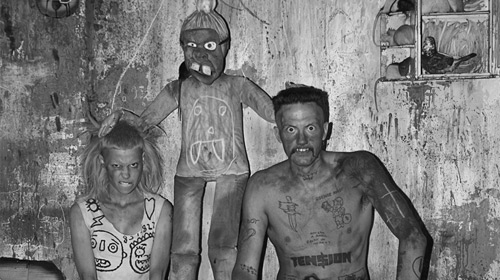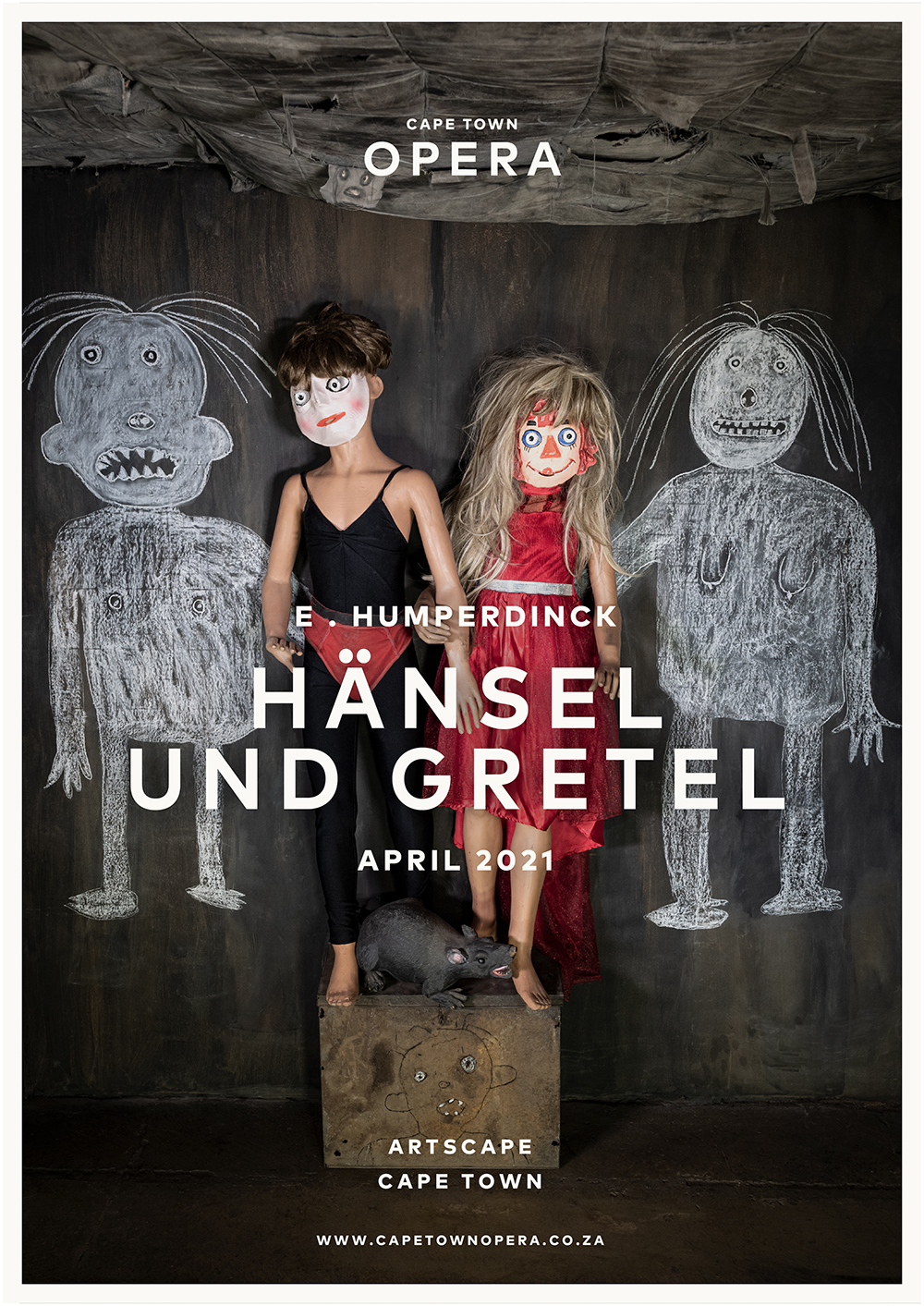Photography’s king of bizarre, Roger Ballen, is taking the fairy tale opera into uncharted visual territory.

SHOCK FACTOR? Die Antwoord in a still from a video by Roger Ballen.
Image: Supplied
Die Antwoord. Yes, that pair of purposefully misshapen artist-musicians; demented fury in their eyes, their angry faces screaming zef rhymes as they toss skeef looks at their transfixed fans.
Their natural habitat? Some derelict, disturbed environment tinged by overt impoverishment, mental anguish scratching at the broken window. Outside, the grass is dead, barking dog chained up and rabid. Inside, primitive drawings drip from dilapidated walls, fiendish dolls smirk in the corner, scary wire-hanger sculptures hang from hooks and God knows what else is lurking in the dingy shadows — or under the half-broken bed.
You know the stuff I’m talking about. It’s not everyone’s cup of tea.
It could come as a shock to learn that this world inhabited by Ninja and ¥o-Landi Vi$$er (the duo who are Die Antwoord), a staged setting for their perverse antics, was coaxed out of the ether by Roger Ballen, ranked among the world’s greatest living photographers.
You might, of course, have other, more highbrow points of reference for Ballen. Art museums and photo galleries, perhaps. Or coffee table books. Also not everyone’s cup of tea.
Ballen made his name while still a hobbyist, taking pictures of white outsider communities in rural SA towns. They were controversial images; some called them exploitive, others questioned their uncomfortable politics.
| His job, he says, is to organise the material he excavates deep inside his own mind and find compelling ways of revealing it to the world. |
And yes, they were uncomfortable. Ballen, however, says your reaction to his work says more about what you’ve got repressed in your own psyche. He, on the other hand, doesn’t distinguish between light and dark. He has no hierarchy of beauty that conforms to familiar standards.
By the mid-1990s, his documentary portraits of inhabitants of seemingly hellish backwaters began to take on a theatrical quality and what evolved was an aesthetic that straddled reality and fantasy, that elided distinctions between documentary and fiction. Ballen began staging his pictures, incorporating in his composed scenes various found objects and artefacts that became signatures of his work — the debris and detritus of lives lived at the fringes, somewhere in the wasteland of despair and poverty.
He created surreal, shocking distortions of reality. Real people — dishevelled, disturbed, marginal — were placed in weird, sinister settings or in situations characterised as eerie or nightmarish. Framed by peeling walls, sad furniture, spooky drawings, disembodied dolls and grisly animals, they wore dirty old clothes and inexplicable expressions.
Ballen established himself as a visual curator of humanity’s interior world. The landscape of the human psyche being the thing he’s concerned with.
His job, he says, is to organise the material he excavates deep inside his own mind and find compelling ways of revealing it to the world.
Which brings us to Ballen’s latest collaboration, this time as designer on the opera Hänsel und Gretel, which had its premiere in 1893. It’s characterised by a lush, velvety, uplifting score that, in Germany, has made it a popular Christmas-time production. Written by the post-Wagnerian composer Engelbert Humperdinck (not the eponymous 1970s crooner), it’s a sugar-coated version of the familiar Grimm brothers’ fairytale, so family friendly in fact that it’s regarded as the ideal children’s starter opera.
And what’s not to love? It has a pair of hungry innocents for protagonists, a fairy and a sandman in the enchanted (or perhaps haunted) forest, and a witch who makes snacks out of children whom she imprisons in her gingerbread house. Cannibalism and child abduction notwithstanding, the librettist (Humperdinck’s sister) actually covered up many of the darker, more macabre elements originally penned by the Grimms.
Which means that, if you scratch a bit at the surface, there’s plenty of menace and traumatic psychological residue lurking below. Bringing these aspects into view is what SA-born, Italy-based director Alessandro Talevi intends achieving by setting the Cape Town Opera production within a world created by Ballen. If all goes to plan, it’ll be one where the often unsayable dimensions of the human psyche spill out into the stage and the artist’s visual language of archetypal images and symbols are juxtaposed with the upbeat score and sugary songs.

“Sets for a fairytale can be built in all sorts of ways,” Ballen says. “You could opt for the typical sweet scenario with butterflies fluttering between the trees. Or you can create a world that represents breakdown and chaos, reveals psychological instability. A world in which the psyche’s deepest fears are visible and where anarchy reigns. Such are the archetypal states that pervade the Ballenesque universe.”
For Ballen, it is not enough to simply represent chaos in the form of a rundown or dilapidated building, though. Instead, he creates richly layered aesthetic environments that “reverberate in the viewer’s mind”. In other words, he wants the visual world to touch you deeply, unlocking something within you, affecting a kind of transcendental shift.
To achieve this intricately layered topsy-turvy aesthetic, Ballen says he journeys deep within, extracting material from his own psyche. This he orders and organises visually to convey meaning. His staged scenes — organic arrangements of drawings, sculptures, paintings, physical props and found objects, animals, humans and other visual information — have the effect of intensifying the absurdity and alienation of a situation.
They also function as a metaphor for the mind itself, filled with recurring symbols.
Talevi says among various readings of the Grimm brothers’ story, one he’s quite keen to exploit is a Freudian interpretation. “That the story is about the dangers of falling back on your carnal instincts, of base oral and physical satisfaction. In Hänsel und Gretel, it comes down to that most immediate human impulse — to fill your mouth. Which in a Freudian context is related to not wanting to grow up, not wanting to leave the mother’s womb.”
If all of this sounds harrowing, like a trip to the therapist you’re disinclined to take, it might be worth the risk. Once you get over yourself and face what you’ve repressed, the surreal scenarios Ballen creates are filled with plenty more that’s worth chewing on.
| The only restriction is that they need to be able to move and sing. Which means they probably won’t be gagged or have anything covering their mouths.
Marguerite Rossouw |
You may also be surprised by the humour, however dark, that’s part of his visual vocabulary. It’s evident in his uncanny pairings, bizarre framing and unexpected entanglements and arrangements of household detritus, misshapen bodies, decapitated dolls and what-have-you. There’s meaning in his method: he is calling out the absurdity of human existence, recognising in the broken images and forlorn emptiness of his scenes that we are trapped in chaos and there is no escape.
And there is a concurrent strain of black comedy that runs in the Grimm brothers’ strange concoction too.
Talevi says the witch may persecute, imprison and eat children, but she is naughty in a depraved, lunatic, OTT manner. “She’s macabre and sardonic, and audiences will laugh in shock at what she gets up to.”
Never mind that, in the end, it’s the children who outwit the old crone, shoving her into her oven, presumably to the great satisfaction of the audience. Whichever way you look at it, it’s a pretty perverse way of settling a score.
Given the probable hype around the Ballenesque sets and costumes, it’s easy to forget there’ll be an orchestra in the pit and a cast of singers belting out extraordinary harmonies. They’re the reason the show exists in the first place — those voices, with Humperdinck’s luxuriant score, are the opera’s muti. And they’re also what will ensure this Ballenesque universe exists in a dimension that is perhaps parallel to the one created for Die Antwoord.
The opera’s sweet-voiced singers will be costumed so they sync perfectly with Ballen’s world. A unique wardrobe is being designed by the photographer’s creative collaborator, Marguerite Rossouw, who has worked by his side for 14 years.
Rossouw says Talevi has given her full rein to make the performers look as if they are part of the photographer’s realm. “The only restriction is that they need to be able to move and sing,” she says. “Which means they probably won’t be gagged or have anything covering their mouths.”
Let’s hope not. Or we’ll be stuck permanently in that needy oral phase.
Cape Town Opera’s production of Hänsel und Gretel premieres on April 1, with four performances at the city’s Artscape Theatre. All shows are subject to Covid-19-mitigation protocols, including limited seating and possible postponement.

Comments are closed.